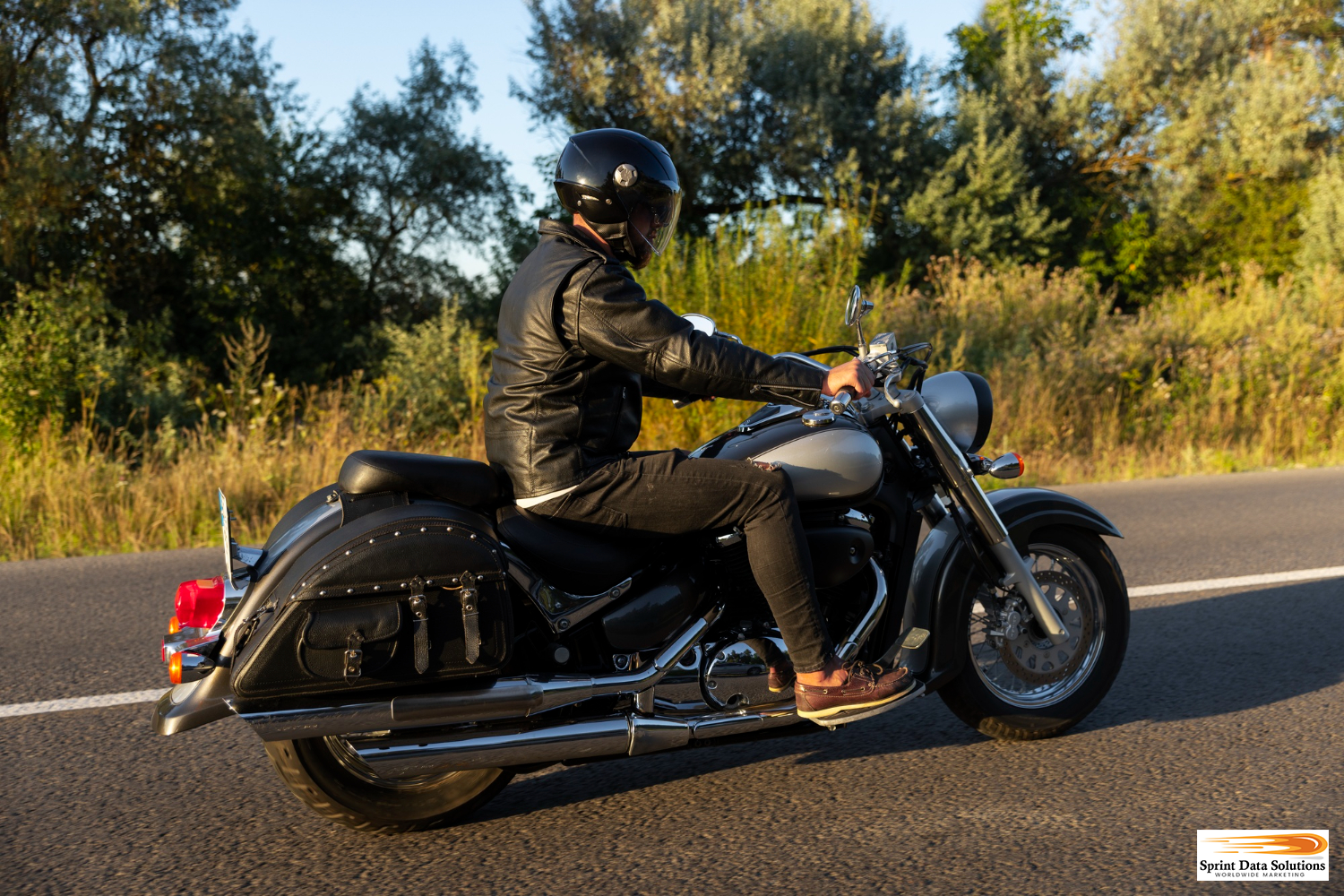Trike Owners Are A New & Growing Market
America’s history is relatively young compared to many other nations, and this youth has uniquely positioned it to evolve rapidly, embracing innovation that keeps pace with the times. One of the most iconic examples of this is the nation’s sprawling and sophisticated transportation infrastructure, particularly its vast network of streets, highways, and interstates. For decades, these highways have not only served commuters but also empowered Americans to travel across the country, explore diverse regions, and access remote destinations. The automobile has long been central to American culture, offering an unparalleled sense of mobility and freedom.
In this context, the motorcycle has become an enduring symbol of that freedom—conjuring images of open roads and adventure. With roots deeply embedded in American history, motorcycles are not only a mode of transportation but a way of life for many. However, the evolution of transportation has brought forth a new player: the trike motorcycle. This hybrid of motorcycle and tricycle offers greater stability, comfort, and accessibility, opening up new possibilities for riders who may have previously found traditional two-wheeled motorcycles less practical.
For businesses in the motorcycle industry, this shift represents both a challenge and an opportunity. The trike motorcycle market is rapidly expanding, attracting a diverse range of customers who appreciate the stability and ease of riding while still enjoying the thrill of the open road. This burgeoning market is not only growing in numbers but is also becoming increasingly diverse in terms of demographics and preferences. Companies looking to tap into this emerging market must adapt their offerings to meet the unique needs of these riders.
Sprint Data Solutions Worldwide Marketing has recognized the potential of this shift and is already helping businesses navigate this expanding market. With its deep expertise in customer data acquisition and marketing analytics, Sprint Data Solutions is equipped to assist businesses in targeting the right audiences for the trike motorcycle sector. By offering accurate and up-to-date databases, as well as tailored marketing strategies, Sprint Data Solutions is ensuring that businesses can reach the customers who are most likely to be interested in these innovative vehicles, ultimately driving sales and expanding their market reach.

What Is A Trike Motorcycle?
A trike motorcycle, often referred to as a “motorized tricycle,” shares many design similarities with traditional motorcycles, but with the key difference being the addition of a third wheel. This three-wheeled configuration enhances the vehicle’s stability, making it an appealing choice for certain riders. Trikes can be designed with two wheels in the front and one in the rear or with one wheel in the front and two at the back. The choice of configuration typically depends on the rider’s preferences and the manufacturer’s design philosophy.
The concept of three-wheeled motorized vehicles isn’t a recent innovation. In fact, the trike’s roots date back to the 19th century when inventors and engineers experimented with various vehicle configurations to determine the optimal design for motorized transport. During this period, multiple attempts were made at creating vehicles with more than two wheels, as the automotive industry was still in its infancy. However, by the 20th century, vehicles with two or four wheels became the dominant forms of transportation. Still, trikes occasionally made an appearance in different forms, particularly in the niche markets of utility vehicles and recreational rides.
The modern resurgence of trike motorcycles can be traced back to the early 21st century when motorcycle enthusiasts, particularly those looking for added stability, began to seek out customized conversions of traditional two-wheeled motorcycles into three-wheeled configurations. These “motorcycle trike” conversions were initially done on a small, local scale by custom builders, offering riders the benefits of increased stability, ease of handling, and a slightly different riding experience compared to traditional motorcycles. These custom conversions gained a loyal following, especially among older riders or those with physical disabilities, as the additional wheel provides a more stable platform without compromising the power and performance characteristics of a motorcycle.
In 2009, Harley-Davidson, one of the largest and most iconic motorcycle manufacturers, took a bold step by introducing a factory-produced motor trike. This move helped bring the trike concept into the mainstream, further legitimizing the three-wheeled motorcycle as a serious option for riders. Harley’s entry into the trike market was quickly followed by other major manufacturers like Yamaha, Can-Am, and Indian Motorcycles, each offering their own variations of three-wheeled motorcycles.
Today, trikes have evolved beyond just a curiosity for custom builders and enthusiasts; they have become a staple of the motorcycle market, particularly for those looking for a more accessible and stable ride. Trikes appeal to a broad range of riders: from those seeking the thrill and freedom associated with motorcycles but requiring more stability, to those with physical limitations who may find traditional two-wheeled motorcycles challenging to handle. Trikes are also favored for their ability to handle heavier loads, such as additional passengers or luggage, making them ideal for long-distance touring or as a more practical option for certain riders.
The growing popularity of trikes can be attributed to several factors. Advances in design and engineering have made trikes more comfortable and performance-oriented, addressing the initial perception that they were less agile or too cumbersome. The appeal of trikes also lies in their unique balance of stability and power, which allows riders to experience the freedom of the open road without the same degree of skill or balance required for a two-wheeled motorcycle. Additionally, trikes offer riders the ability to carry more gear, making them an excellent option for long-distance tours or even motorcycle camping.
While traditional two-wheeled motorcycles continue to dominate the market, trike motorcycles are rapidly becoming a larger part of the motorcycle demographic. With major manufacturers entering the fray, the trike has transformed from a niche market to a growing segment of the broader motorcycle industry. Whether for recreational use, touring, or as a more stable alternative to a traditional motorcycle, the three-wheeled motorcycle offers a unique experience that continues to attract new riders from all walks of life.
The Trike Difference
Trikes, or three-wheeled motorcycles, have gained popularity for far more than just their unique look or fashion appeal. The primary benefit of having three wheels instead of two is enhanced stability. With the addition of a third wheel, riders no longer have to worry about manually balancing the vehicle, as is necessary with traditional motorcycles. This makes the riding experience less physically demanding, particularly for those who may have physical limitations. In this way, trikes offer similar stability to a car, allowing riders to remain upright without constantly adjusting or balancing the vehicle.
The origins of the three-wheeled motorcycle are deeply rooted in the needs of motorcycle enthusiasts who were seeking an alternative due to physical limitations or age. Many riders, particularly as they grew older or faced challenges from accidents or injuries, began finding it difficult to safely balance and operate a two-wheeled motorcycle. These riders still longed for the thrill and freedom of motorcycle riding but required a safer and more stable platform to enjoy it. Trikes were initially born out of custom modifications made by small businesses catering to this niche market of aging or disabled motorcyclists. By adding a third wheel, these custom trikes allowed riders to continue enjoying the open-air experience, without the physical strain of maintaining balance.
Beyond those seeking alternatives due to age or injury, trikes also offered a unique learning platform for new riders. For individuals who were unfamiliar with motorcycles or who may have had concerns about handling a two-wheeled vehicle, the trike configuration offered an easier, more accessible way to experience the joys of motorcycling. Unlike traditional motorcycles, the added stability made it easier for newcomers to learn and ride with less anxiety about tipping over, making it a welcoming option for people of all experience levels. Additionally, this stability allowed riders to focus on enjoying the ride without the mental burden of worrying about balance or control, enhancing the overall riding experience.
As the trike market grew, it transitioned from a custom modification to a viable option offered by larger manufacturers, making it accessible to a wider range of riders. Today, trikes are celebrated not only by those with mobility challenges but also by younger riders who appreciate the added stability, unique design, and open-air experience they provide.
The trike’s rise in popularity can be attributed to its ability to offer a solution for individuals who may have been deterred from traditional motorcycles due to physical limitations or a reluctance to meet the physical demands that conventional bikes require from riders. Unlike standard motorcycles, which typically require a certain level of balance, coordination, and strength, trikes provided an alternative that allowed people to continue enjoying the motorcycle experience without needing to master those physical challenges. Initially, trikes were niche products offered by smaller companies, catering to those who had specific needs or preferences. However, as larger, more established brands like Harley-Davidson recognized the growing demand and appeal of trikes, the shift in perception became clear. Trikes not only allowed older or less physically capable individuals to remain within the motorcycle community but also opened the door to an entirely new demographic of riders who might have previously dismissed the idea of riding a traditional motorcycle.
Harley-Davidson and other mainstream manufacturers realized the potential market within this segment—one that was expanding in both size and diversity. By tapping into the trike market, these companies could retain loyal customers who were aging or dealing with physical challenges while attracting a younger, more diverse group of riders who may have been drawn to the unique appeal of three-wheeled vehicles. Additionally, the trike offered an alternative to consumers who might have found motorcycles too intimidating or physically demanding. As larger corporations recognized the viability of this market, it became clear that it was not merely a niche but a growing segment of the motorcycling world, one with significant potential for mainstream growth.
Today, the trike market has expanded far beyond traditional models, with new innovations emerging to cater to even more diverse tastes. One such example is the Polaris Slingshot, a vehicle that redefines the concept of three-wheeled motorcycles. Unlike traditional trikes that maintain motorcycle seating and controls, the Polaris Slingshot introduces a two-seat configuration with a steering wheel, offering a driving experience that closely resembles that of a car. Despite this departure from traditional motorcycle design, the Slingshot and similar vehicles are still legally classified as motorcycles, which speaks to the evolving nature of the motorcycle industry and the ways in which it has adapted to meet the demands of modern riders. As manufacturers continue to innovate and evolve, it’s clear that the trike market has moved well beyond its niche origins and is now an integral part of the larger motorcycle ecosystem.
Who Is The Market?
Trike users are a diverse group that includes many individuals from the traditional motorcycle demographic, but the appeal of trikes extends beyond just seasoned riders. While many trike users share characteristics with motorcycle enthusiasts, such as a love for the open road, a sense of adventure, and an interest in the freedom that riding offers, there are notable differences. The market for trikes has been steadily expanding, with several key groups embracing these three-wheeled vehicles.
Older riders, particularly those seeking increased stability and comfort, are a significant segment of the trike market. These individuals often have years of experience riding motorcycles but may find it increasingly challenging to balance a two-wheeled motorcycle, especially due to physical limitations. Trikes offer an ideal solution, providing the freedom and excitement of riding with the added benefit of greater stability and ease of handling.
In addition to older riders, individuals with physical disabilities or mobility issues are also increasingly turning to trikes. For these riders, a trike offers a more accessible option compared to traditional motorcycles, allowing them to continue enjoying the thrill of riding while addressing specific needs for support and balance. Trikes often feature enhanced comfort and accommodations, such as lower seats or more accessible footrests, making them a suitable choice for individuals with varying physical abilities.
Moreover, there is a growing interest among younger riders and those new to motorcycling. Trikes provide a unique entry point for these individuals, especially those who may be hesitant about riding a two-wheeled motorcycle due to safety concerns. The enhanced stability of a trike offers newcomers a sense of security, enabling them to enjoy the experience of motorcycling without feeling as vulnerable as they might on a two-wheeler.
Furthermore, adventure seekers and touring enthusiasts are increasingly adopting trikes as their preferred mode of transport. Trikes offer ample storage space for long-distance touring, making them an attractive option for those who enjoy extended trips. With their ability to carry luggage and other gear comfortably, trikes are becoming popular among individuals who want to travel the open road over long distances without sacrificing comfort.
Lastly, trikes have been gaining traction in the luxury and leisure market. Some individuals opt for trikes as a premium recreational vehicle, valuing the unique experience they offer and the ability to personalize them with custom features and designs. This trend reflects the growing popularity of trikes as more than just a mode of transportation but also a statement of lifestyle and individuality.
In summary, while the core demographic of trike users overlaps with that of motorcycle riders, the appeal of trikes is broadening to include older adults, those with disabilities, younger beginners, long-distance travelers, and even luxury-seeking individuals. The versatility and appeal of trikes continue to grow as these vehicles cater to a wide range of personal preferences and needs.
Elderly Riders
Trikes have long been a popular choice for motorcycle enthusiasts, and their appeal remains as strong as ever, especially among the senior demographic. Motorcycles have been a defining part of American culture for decades, with many of today’s older adults having ridden them during their younger years. However, as people age, they often experience a range of physical challenges that can hinder their ability to ride traditional motorcycles. Issues such as joint pain, reduced balance, and limited strength can make it increasingly difficult to manage the demanding skill set required for handling two-wheeled motorcycles. Trikes, with their added third wheel, offer a solution that allows riders to continue enjoying the freedom and thrill of motorcycle riding without the challenges of balancing or counter steering.
This transition to three-wheeled vehicles is especially significant for senior citizens who may not be ready to give up the open-road lifestyle. Trikes enable them to maintain the joy of cruising on the open road, while providing added stability and comfort. In fact, the demand for trikes among older riders has led to the growth of a specialized market, where manufacturers and service providers are focusing on products and services designed to meet the unique needs of seniors. These can include enhanced comfort features such as adjustable seats, better shock absorbers, and more accessible controls. Additionally, accessories and modifications tailored to seniors, such as ergonomic grips, advanced navigation systems, and safety gear designed for ease of use, are increasingly available.
The rise of the senior trike market represents a new chapter in the world of motorcycles, offering older riders the opportunity to continue enjoying the open-air freedom that motorcycles are known for, while addressing the physical limitations that come with aging. It also creates numerous business opportunities, from customizations and upgrades to specialized services aimed at maintaining and enhancing the trike experience. As more seniors embrace this safer and more comfortable alternative, the market for trikes and related products is set to grow, providing an exciting new avenue for both the motorcycle industry and businesses catering to older consumers.

Disabled Riders
Certain disabilities can make even operating a car challenging or impossible, such as blindness or severe cognitive impairments. However, for individuals with physical disabilities, such as wheelchair users, amputees with a single limb loss, or those with certain types of paralysis, driving can still be a viable option with specialized modifications. While traditional motorcycles demand a high level of physical coordination, motor trikes provide an alternative that allows individuals with mobility challenges to experience the thrill of motorcycling while also enhancing their safety and independence.
The key appeal of motor trikes lies in their ability to accommodate a wide range of disabilities, especially for riders who face difficulty with balance or controlling a two-wheeled motorcycle. Unlike regular motorcycles, which require riders to balance the bike manually, motor trikes offer a stable platform. This eliminates the need for countersteering, which can be difficult for those with limited limb mobility or strength. Furthermore, custom modifications make it possible for individuals with specific disabilities to adapt their trikes for easier operation, including modifications that place the clutch, brake, gear shifting, and acceleration controls on the handlebars. This way, riders with single-leg amputations or limited limb mobility can manage all the bike’s functions without needing to use foot controls.
These adaptations enable individuals with mobility challenges to enjoy the same sense of freedom and independence that motorcycling provides to able-bodied riders. Motor trikes have become especially popular among people with spinal cord injuries, amputations, and other conditions that impair their ability to safely ride a traditional motorcycle. By removing the balance requirements and offering accessible controls, motor trikes allow these riders to enjoy open-road adventures, contributing to their well-being and providing a vital source of personal freedom and empowerment.
People Who Don’t Like Motorcycles
A fascinating trend emerging in the motor trike market is the influx of new riders who may not have considered traditional motorcycles due to their perceived complexity and inherent risks. For many individuals, the thought of balancing a two-wheeled motorcycle or navigating through traffic with limited stability feels intimidating. However, motor trikes offer a safer, more stable alternative. These three-wheeled vehicles combine the thrill of riding with the added security of a broader base, reducing the risk of tipping over that often deters potential motorcycle riders. Some advanced models even feature car-like seating and steering wheels, offering a unique driving experience that closely resembles a small, three-wheeled convertible. The key difference, however, is that these vehicles still require a motorcycle license rather than a regular driver’s license, making them accessible to a broader audience without the need for extensive motorcycle training.
This expansion into a more diverse demographic creates an exciting opportunity for businesses. The customer base for motor trikes extends far beyond the typical motorcycle enthusiasts to include individuals who may have once felt excluded from the world of motorcycling due to concerns about safety or skill level. With such diversity in mind, businesses now have the opportunity to market additional products and services that could cater to this growing group of riders. These might include specialized insurance plans, riding gear, accessories, and even non-riding services such as road-trip planning or customizations. Sprint Data Solutions Worldwide Marketing plays a vital role in this shift by providing accurate, up-to-date marketing data that can help businesses target the right customer profiles for motor trikes and related offerings. By tapping into their comprehensive and continually updated databases, companies can develop tailored campaigns that resonate with this newly expanded audience, enhancing engagement and boosting sales potential.
Who Is Sprint Data Solutions Worldwide Marketing?
Sprint Data Solutions Worldwide Marketing is a distinguished American-owned and operated business, founded with the vision of economic growth rather than defense. The company was born from the aspirations of a disabled veteran who, after fulfilling their military service, sought to contribute to the nation’s prosperity by helping businesses thrive. Rather than focusing on defense, the company’s mission centered on one of the most vital elements for success—customers. By focusing on expanding the client base of businesses, Sprint Data Solutions Worldwide Marketing quickly gained recognition for its commitment to driving growth through innovative marketing solutions.
Originally established in Las Vegas, Nevada, the company initially focused on assisting local businesses. The strong foundation of quality service, integrity, and dedication to customer satisfaction fostered steady growth and earned the company a trusted reputation in the community. This commitment to excellence has helped the company transform from a small local operation into a national leader in the marketing industry. Today, Sprint Data Solutions Worldwide Marketing proudly employs a team with over 50 years of collective experience, providing expert services to businesses across the globe.
Sprint Data Solutions Worldwide Marketing entered the marketing world when traditional advertising platforms such as radio and television were dominant, and digital marketing was still in its infancy. The company’s early dedication to direct mail marketing laid the groundwork for expertise in the essential skills of data acquisition, management, and analytics. By focusing on building accurate and reliable databases, the company provided clients with valuable insights to enhance their marketing efforts. As digital marketing rapidly gained traction and became a major force, Sprint Data Solutions Worldwide Marketing quickly recognized the potential of this new avenue. The company was ahead of the curve in adapting to digital marketing trends, incorporating cutting-edge technologies to provide clients with comprehensive marketing services.
By integrating digital marketing with its established direct mail expertise, Sprint Data Solutions Worldwide Marketing capitalized on the early growth of digital platforms, securing a competitive advantage that propelled both the company and its clients to greater success. Today, Sprint Data Solutions Worldwide Marketing is a well-respected leader in marketing services, offering an extensive range of data-driven solutions that help businesses achieve their goals. Their ability to leverage both traditional and modern marketing techniques ensures that their clients reach the right audience with the right message, maximizing the potential for engagement, sales, and long-term growth.
This success prompted a significant expansion of the company’s service offerings. Initially, operations were limited to Nevada, serving local clients within the state. However, as demand grew, the company broadened its reach to encompass the entire United States, extending its coverage to include Alaska and Hawaii. This expansion continued with the addition of international markets, first extending to Canada and Mexico, and later branching out to offer full continental coverage. In recent years, the company has successfully tapped into European markets, including France, allowing clients to access new opportunities and extend their reach even further across the globe.

How We Can Help
Sprint Data Solutions Worldwide Marketing has invested years into building an extensive and diverse database of contact information, gathering valuable insights through a combination of proprietary data collection techniques and partnerships with reputable sources. This wealth of information includes a vast range of contact points, such as names, email addresses, phone numbers, and other demographic details, which have been ethically and legally obtained. These methods include opt-in programs for services, subscriptions, surveys, and even business card donations, where individuals have explicitly consented to the use of their data for additional purposes. The company also works closely with trusted partners to expand its reach, ensuring access to a broader, more comprehensive network.
However, Sprint Data Solutions Worldwide Marketing recognizes that the value of any contact database is dependent not only on the size but on the accuracy and relevance of the data. That’s why the company places significant emphasis on continually reevaluating and updating its databases. People relocate to new residences, change jobs, and, unfortunately, pass away; each of these events can affect the accuracy of the information. To address these concerns, Sprint Data Solutions Worldwide Marketing employs stringent protocols, utilizing tools such as the National Change of Address (NCOA) and Certified Address Accuracy System (CAAS) to ensure that only the most up-to-date and valid contact information is included in their lists. This attention to detail is vital, as it ensures that clients receive reliable, actionable data that reflects current circumstances.
Furthermore, the company understands that simply having access to large volumes of data is not enough. To make the data truly valuable, Sprint Data Solutions Worldwide Marketing utilizes cutting-edge AI-powered analytics systems. These machine learning algorithms are designed to sift through vast datasets, organizing and filtering information based on a set of specific client parameters. Whether clients are looking for particular geographic locations, specific demographic characteristics, or even behavioral patterns, the data is carefully sorted and categorized to match these criteria. This advanced data organization ensures that clients receive highly targeted, relevant leads, rather than a generic list of contacts. With this combination of ethical data collection practices, constant data validation, and sophisticated AI analytics, Sprint Data Solutions Worldwide Marketing delivers not only quantity but also the quality and precision that modern marketing campaigns demand.
A key feature of these contact databases is their geographic flexibility. These databases can be customized to fit the specific needs of a campaign, whether it’s for a national outreach or a more localized, targeted effort. National-level access allows businesses to launch broad-reaching campaigns across the entire country. However, for more tailored campaigns, the geographic scope can be refined. For instance, a campaign can be narrowed down to focus only on a particular region, like the Pacific Northwest, or even zoomed in further to target a specific state, such as Oregon. For hyper-targeted initiatives, the focus can be even more specific, reaching down to a neighborhood level. For example, a campaign could focus solely on residents of the Pearl District in Portland, ensuring the marketing message reaches only the most relevant audience in that particular area.
Equally important to these databases is the detailed demographic segmentation, which enables marketers to tailor their outreach efforts with a high degree of precision. The database doesn’t just provide contact details but offers a rich set of characteristics that make each contact a unique individual, aligning the campaign message to resonate deeply. Key demographic metrics include ethnicity, religious affiliation, income level, age, and even specific health conditions. For example, a campaign for a health product may benefit from focusing on consumers with asthma or other respiratory conditions. Similarly, campaigns for religious or faith-based products can use data based on religious affiliations, like targeting Catholic communities for products or services aligned with their beliefs. Economic rankings can help target consumers based on their financial status, whether for high-end or budget-friendly products. Age-specific targeting allows for reaching younger or older demographics based on the product’s relevance to those age groups. These highly granular insights ensure that marketing efforts are not just sent out to random contacts but are strategically directed to people whose specific needs, preferences, and circumstances make them more likely to engage with the content, ultimately resulting in higher response rates and more meaningful interactions.
Contact Formats & More
Sprint Data Solutions Worldwide Marketing offers a diverse range of contact databases tailored to various marketing needs. Whether you’re seeking to reach general consumers, business professionals, or specific target groups, our comprehensive contact lists are available in formats that suit your strategy. For businesses focused on direct mail campaigns, we provide physical mailing addresses for both consumer and B2B outreach. In addition, we offer email contact details for individual and corporate communications, allowing for targeted messaging based on customer preferences.
For businesses looking to engage through more personal communication channels, we supply residential telephone numbers as well as direct contact information for key decision-makers at the B2B level, ensuring you reach the right person every time—not just a general receptionist. Additionally, we offer mobile phone numbers, making it easy to execute text/SMS campaigns that resonate with your audience.
At Sprint Data Solutions Worldwide Marketing, we recognize that some companies may lack the experience or resources to effectively manage their marketing campaigns. For these clients, we offer a robust turnkey direct mail solution, designed to streamline the entire process. From initial campaign conception to final delivery, we guide clients through every phase of the direct mail journey. This all-in-one service eliminates the need to coordinate with multiple vendors, ensuring a seamless, efficient experience with quality results.
If you’re targeting niche markets, such as trike owners or any other specialized group, Sprint Data Solutions Worldwide Marketing has the precise leads to make your campaign a success. Reach out to us today, and let us provide you with the data and support you need to effectively connect with your ideal audience.






